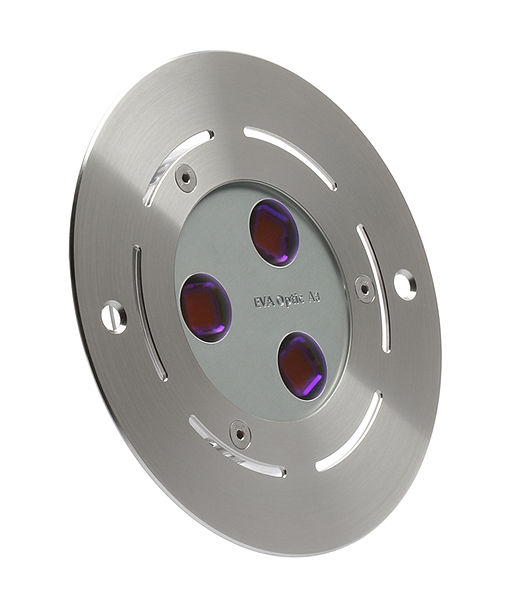Underwater Lighting is a type of Lighting specially designed for use underwater. This lighting must meet the degree of protection IPX8 which means that the underwater light is dust and water resistant according to IEC 60529. Underwater lighting operates on low voltage, 30Vdc max according to standard IEC60364-7-702.
Types of underwater lighting
Halogen vs. LED
As with other types of lighting, for underwater illumination different light sources are used. Traditionally, underwater lights are equipped with halogen lamps. For several years, led underwater lighting is emerging in the market. The advantage of led is that this light source (under the condition of correct application) has a much longer lifespan than halogen. By comparison, a halogen underwater light has up to 1,500 burning hours, while a LED underwater lamp can reach 50,000 burning hours
Energy comsumption
The switch from halogen to LED has a significant effect on the energy consumption of underwater luminaires. There are now LED underwater lights on the market with a power consumption of 45W with significantly higher light output than a 300W halogen underwater light.

Fixture design
Many manufacturers have, in switching to LED, built upon the existing design of the halogen underwater light fixture which must be opened in order to replace the light source. For halogen lighting this is approximately 2 times per year (depending on intensity of use). As the lifetime of LEDs in theory is 20 to 50 times longer than halogen, some manufacturers have responded to this with a new design in which the light source is sealed-off water and airtight with special resin. This new generation of LED underwater lights have fewer problems with waterproofing.
Light Output
The unit of Luminous flux is measured in Lumen. For a good comparison between different underwater lights, it is recommended to compare the luminous flux in lumens of underwater luminaires.
Candela vs. Lumen
As with other types of lighting, the arrival of led has arisen many questions about the light output of lamps. Much of the confusion about light intensity is caused by the mix-up between Candela and Lumen. Manufacturers are not always clear in providing information about light output of an underwater lamp. The most powerful high-power LEDs for underwater use (2011) can produce up to max. 120 lumens per watt. A quick calculation then indicates that a 60W LED underwater lamp in optimal conditions (depending on driver, power and cooling) has a maximum luminous flux of 7,200 lumens.
Relationship Candela and Lumen
For example: a lamp that emits 590 cd in an angle of 40°, sends out about 223 lumens. In calculating Candela to Lumen also take into account the beam angle, meaning the width of the beam. There are underwater lights with a narrow beam (25-30 °) which reach further and underwater lights with a wide beam (120-140 °) which can illuminate a pool evenly without dark corners. For safety reasons, public swimming pools often choose the latter.
LED type
Also affecting light output is the type of LED used in an underwater fixture. Here are three distinct types:
- LEDs with a low wattage (0.5W - 1W per LED)
- Power LEDs with a higher power (3W per LED)
- High-Power Chip LEDs (15-35W per LED)
An underwater luminaire with low power LEDs can be identified by the large number of LEDs in the Luminaire, sometimes 50 to 100 per fixture. The low power does not allow high light output. Only luminaires with Power LEDs and High Power Chip LEDs have the capacity of reaching light outputs similar to 150W halogen underwater lights and higher. In this type of LED lights, sufficient cooling of the fixtures is necessary due the LEDs generating heat, which does not occur with low power LEDs.





